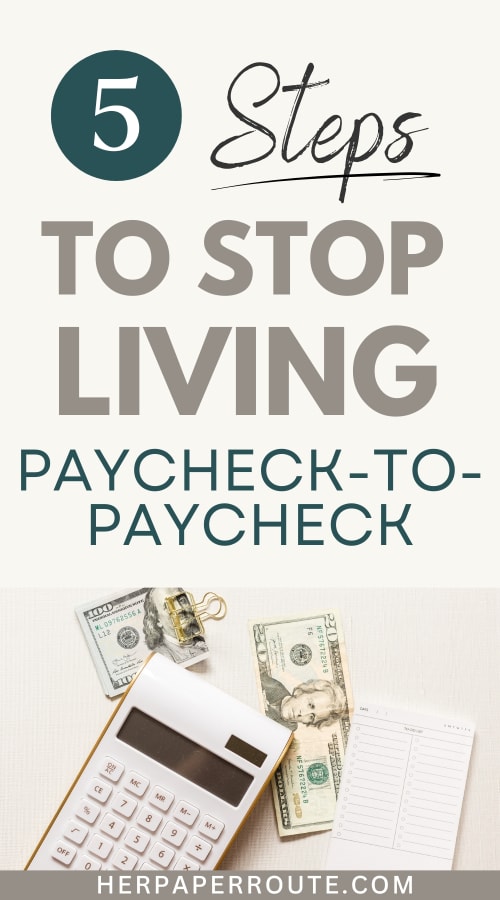How To Stop Living Paycheck To Paycheck (5 Easy Steps)

How to stop living paycheck to paycheck – a realistic guide. How many times have you tried to start a budget, only to drop it after a week?
Maybe you thought you didn’t have the time or it was just too hard to stick to.
As an affiliate partner of various brands and sponsored content, HerPaperRoute may earn commission on qualifying purchases. Disclaimer
It is possible to stop living paycheck to paycheck, and it doesn’t have to be all that difficult or time-consuming. One of the ways to take the stress out of managing your money is to create a budget, obviously.
But just like when starting a fitness journey, the hardest part is actually sticking to it. More than anything, your mindset to stay on track is what will determine how successful you will be at this.
To help you, I’ve created an easy paycheck to paycheck budget planner, which you can download and use today for free.
This will help you manage your income and expenses, and even suggests some ways you can make more money.
With this free budgeting planner, you’ll be able to stop living paycheck to paycheck in no time. Access it via the form below:
Once you’ve got your budget planner, I’ll send you a weekly email with money making and money saving tips to help motivate you to stay on track.
Take a look at the steps below to get started on your financial diet.
How To Stop Living Paycheck To Paycheck
You may be surprised to know how many Americans live paycheck to paycheck. A shocking 78% do, and struggle to make ends meet in between.
Deciding that you are ready to learn how to stop living paycheck to paycheck is the first step in reaching debt free living. So congrats, you are well on your way.
Don’t forget this can actually be easy. Truthfully, the most difficult part is on you, to commit to sticking to it.

Once you have taken into account all of your expenses, it takes the stress out of figuring out what to do with each paycheck.
In this post, I’m going to share with you an overview as to how you can start saving money and creating a paycheck to paycheck budget to lower your money stressors.
1. Time to weigh in
Grab your pen and paper, take a seat (you might want to grab a drink first) and start writing down all of your income and expenses.
Note: Use the budget planner worksheet that I mentioned a moment ago for this, it does all the math for you!
Make sure to include your monthly payments that are not debt (utilities, insurance, etc) and those that are debt-related (car payments, mortgage, student loans, etc).
I know these can be difficult to look at, but bite the bullet and get down to it!
2. Don’t forget about those extra pounds…all those random and miscellaneous expenses.
There are two different categories for this.
Those expenses that you actually have to have, like for groceries and those that you probably don’t need, like those random subscriptions that you never really use or could do without.
When I did this I realized I was spending $10 per month for Apple cloud storage, yet I didn’t need to, because my Amazon Prime membership includes a huge amount of cloud storage for free.
It’s not a lot but those little expenses can really add up. Dig into what you have and are spending money on, you might be surprised.
You can use the free Trim Financial Manager app to find and cancel your unused subscriptions.
[adsense]
3. Now do the math, add up all those expenses
Now you may need to stop here and get another drink…go ahead, I’ll wait.
Ok now get down to it.
Using the budget planner I gave you, you’ll see that all of your expenses are automatically added up, and subtracted from your income.
Hopefully, you have more income than expenses. If not then you need to make a change, and quick!
First, go back and look at those miscellaneous expenses, what can you cut out without feeling deprived?
When was the last time you used your gym membership? Can you carpool, shop for cheaper groceries, or cancel any random subscriptions you don’t really need or use?
Although I listen to Pandora pretty much all the time, and I hate the commercials, do I REALLY need to pay $5 a month for commercial free listening? NOPE-that’s what I use the mute button for.
Money Saving Tip
How Keegan used meal planning to cut down on expenses:
“Were always stopping somewhere last minute while we were running the kids to their different activities. Or I would make a meal and have leftovers that would go to waste (or to the dogs) due to poor planning.
There is also that issue with running out of something and having to run to the store to get it, although I would at least try to tie this into another trip to save on gas.
In order to avoid this, I started meal planning a lot better and making sure we always had snacks to bring along.”
– Keegan, TheDailyChangeJar
4. How To Save Money Each Month
Now after you have trimmed the fat, it’s time to start saving. So, how to save money each month, you ask?
First, before you can figure out how much money you can save each month, you need to get your spending habits in check.
Make small changes in your day to day spending habits. Make your coffee at home and put that $5 a day you would spend at Starbucks into a jar on the counter.
For example, I saved $19,000 per year when I stopped buying these 8 things.
Just take a minute and think about it. Will buying the latest 70” 4K LED Smart TV really going to make you that much happier?
Or will being debt-free and taking your family on a fully paid vacation make you happier? I know which one I would choose.
- Being smart with your money can help you to live within your means, whatever that may be.
- It will also help you understand what money really means to you. It is possible to get a lot further on less.
Once you have gone through all of your bills and random expenses and your income is more than your expenses, you are headed in the right direction.
Now you have to figure out a money-saving system that you are comfortable with and can stick to long-term.
Creating a system to help you save as much as you can, while living comfortably will help you stop living paycheck to paycheck, and break that cycle.
Whether you can save $5 a week or $5 a day, something is better than nothing!
How much of your paycheck should you save?
How much of your paycheck should you save? The answer to this is …well, it depends.
No two families are the same and you aren’t going to have the same expenses as someone else reading this post.
Ultimately, you need to find what is going to work for you. It’s ok if you don’t get it right the first time, there are no right answers right off the bat.
How much of your paycheck you should save will be an experiment for you. You will need to test what is easiest and most practical for you personally.
It’s great to sit here and talk about savings plans in theory, but if you can’t practically implement it in your everyday life, it’s not going to work.
- Your goal may be to save $100 a week or $100 a month, if it puts too much of a strain on your expenses, don’t do it just because you think that is the right thing to do.
Start small and see what works. Saving a little at a time may take you longer to reach your goals, but at least you are saving.
5. Make More Money
Paris Hilton can be seen on the Internet wearing what appears to be a shirt with the words “Stop Being Poor” printed on it. (Which, turned out to be photoshopped. It said ‘Stop Being Desperate’ but still.)
Let’s pretend the shirt was real. Of course, the image of a billionaire wearing a statement that appears to be condemning the less fortunate for their financial situation is just plain cruel, on the surface.
But from a practical, devils-advocate side, the statement ‘stop being poor‘ does have some weight, when it comes to taking control of your finances.

photo source: Gizmodo
Which is what you are doing right now, and I am proud of you for doing so.
You are in control of your financial situation, and you can change it. You have the power to pull yourself out of debt and turn your current struggle into a success story.
You don’t have to count on an employer to give you a paycheck, or a job at all, for that matter.
You can create as many income streams and side hustles as you want to, and have limitless income, thanks to the power of the Internet.
Here are some ideas for ways to make more money
- Sell an online course
- Start a money-making blog
- Start an online store
- Start a subscription box
- Become a dropshipper
- Become a freelance social media manager or influencer
- Get paid to write for blogs and magazines
- Take freelancing jobs
As well, here are 21 passive income ideas, along with 10 top work from jobs. All these things can be done from home, whenever you want to.
There is no reason to depend on your salary alone. The fastest way to stop living paycheck to paycheck is to get in control of your income and make more money on your own terms.
How This Family Stopped Living Paycheck To Paycheck
Here’s how one family of 6 managed to stop living paycheck to paycheck, while living on one main source of income:
“As a family of 6, it was very difficult for us to get started saving. Considering we were starting with a lot of debt and $0 in savings.
Our first step was to build up a savings of $1000 so that we had an emergency fund. This took a bit, but after we cut out some expenses that we didn’t need our savings added up pretty quickly.
Also, any income that I made from random side gigs, went into our savings, seeing my husband’s income covered our bills.
The money went in, bills came out, some went to savings.
To make things super easy and to start small we would take and create an automatic transfer of $5 per week to go into our savings.
When we were comfortable with that we kept increasing that, $5 twice a week and eventually worked up to $5 per day. This was pretty easy as it came out automatically and we didn’t need to think about it.
We also started using the Acorns app. This gave us a way to start investing a little bit here and there without worrying about cutting into our other expenses.
The Acorns app takes your everyday purchases and rounds them up. It then takes that change and invests it for you.
So easy! I don’t even think about it anymore and we are slowly building our retirement nest egg.
Once we got a little more comfortable we implemented the strategy of pretending to live paycheck to paycheck, even though we actually weren’t.
Seeing as how we were used to living paycheck to paycheck anyway, it didn’t seem much different to us.
When you can take all of your “extra” income and put that into your savings or towards paying off debt all that “extra” income can add up pretty quickly.”
How To Stop Living Paycheck To Paycheck – Conclusion
Being on a budget shouldn’t feel like a restrictive diet. It should be empowering to know that you are working towards a better future.
If your paycheck to paycheck budget feels like a corset that’s been pulled too tight and isn’t leaving you room to breathe, reevaluate and see if you can move things around.
Remember, money is money, you can always make more of it, save it, spend it, lose it. This is hard to comprehend when you have very little of it, but it’s true.
Money isn’t everything. Don’t let it stress you out 24/7. Stress is bad for your health, and getting your health back on track is a lot more difficult.
Just like when starting a new diet, the longer you stick with it the greater the results will be.
Hopefully, this post has given you some insight into how to handle your expenses. As well as some motivation to start saving and budgeting today.
Now that you are getting your finances in order, you should read this guide: How to become a millionaire. You’ll be glad you did!
Tell me, how have you developed a savings plan? What worked for you and what didn’t?

Follow along on Instagram!







![What is Your Liquid Net Worth? [Meaning, Tracking, and How to Calculate It] 10 hand holding cash by swimming pool What is Your Liquid Net Worth](https://herpaperroute.com/wp-content/uploads/2022/04/What-is-Your-Liquid-Net-Worth-768x410.png)




